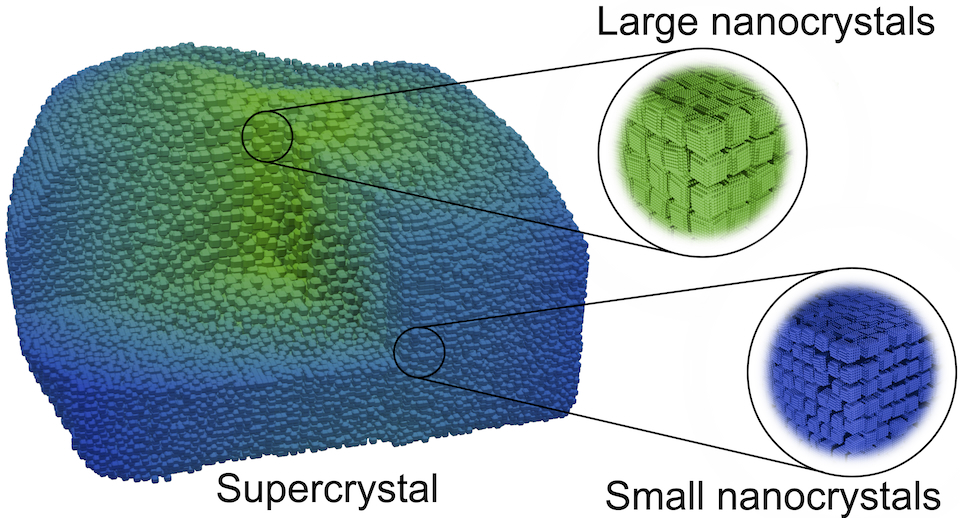Robust supercrystals for the LEDs of the future
Researchers at the University of Tübingen have developed highly stable perovskite supercrystals that could revolutionise the next generation of LEDs and optoelectronic devices. Using a novel two-phase technique and high-precision X-ray analysis at DESY’s PETRA III, the team created robust nanostructures that combine quantum functionality with mechanical stability.
Nanometre-sized crystals of perovskite offer great potential for applications in the field of light-emitting diodes, solar cells and optical switching elements. A particularly interesting arrangement occurs when a large number of these nanocrystals join to form a larger structure – a supercrystal. Researchers at the University of Tübingen have now found a novel way of achieving this. They resorted to a clever technique to produce perovskite supercrystals that are particularly stable and therefore useful. Some important analyses were carried out at DESY: using its X-ray source PETRA III, the team managed to determine the precise structure of the supercrystals. They are now presenting their findings in the journal ACS Nano.
Perovskites, named after the Russian mineralogist Lev Perovski, are a class of crystalline materials with a characteristic lattice structure. Lead halide perovskites are particularly promising, as they can be produced relatively easily by chemical methods and have remarkable optoelectronic properties – which is why these materials are the subject of intensive research. The first practical applications now appear to be within reach: experts are working on high-performance solar cells based on perovskites, as well as on a new generation of highly efficient LEDs and laser chips.

Perovskite nanocrystals are a particularly exciting area of research. “Their optoelectronic properties depend heavily on their size – which is typical of quantum behaviour,” explains Jonas Hiller from the University of Tübingen, one of the authors of the study. “Because of this, their properties can be specifically customised. The energy of the light they absorb or emit varies depending on their composition and their size.”
Under certain conditions, these perovskite nanocrystals can form larger structures, creating a supercrystal. “This is a crystal made up of crystals,” Hiller explains. “You can compare it to a Rubik’s Cube, which is made up of several smaller cubes.” The exciting thing is that while the individual nanocrystals retain their desired quantum properties, they can be handled as a macroscopic unit and thus deployed in practical applications.
Forming a supercrystal in two phases
Until now, supercrystals like this have been created by allowing a solvent containing the perovskite to slowly evaporate. The resulting structures form very gradually on the substrate. “However, the supercrystals are produced at random sites around the substrate,” explains the project manager Ivan Zaluzhnyy from Tübingen. “Also, the individual nanocrystals are surrounded by a protective layer of organic molecules, which makes the entire supercrystal very soft.” As a result, they break very easily when you try to move them around mechanically. This poses a real obstacle for applications in which the positioning of the materials is crucial, such as between two electrodes in an electrical component.
To solve this problem, the team opted for an alternative approach: two-phase diffusion. A solution containing the nanocrystals is layered on top of a second liquid: acetonitrile. This acts as an anti-solvent for the perovskite crystals. As it slowly penetrates the solution containing the nanocrystals, it gradually reduces their solubility. “This results in crystal growth beginning at the boundary surface between the two phases,” explains Jonas Hiller. The acetonitrile displaces the organic molecules coating the crystals, resulting in a firmer, more stable structure.
In order to examine the structure of these supercrystals more closely, the team used the narrow X-ray beam at GINIX, an instrument installed on the P10 beamline at PETRA III. “The beam diameter of just 300 nanometres makes it possible to examine different regions within a supercrystal with high precision,” explains DESY physicist Wojciech Roseker. And Jonas Hiller adds: “The extremely high quality of the diffraction data was a key element of this study. It enabled us to analyse the structure of the supercrystals in great detail.”
The team found that the supercrystals produced typically had an area of 10 by 10 square micrometres but were significantly thicker than the comparatively flat structures that could be achieved using the old method. Their height was more than five micrometres, which improves their stability. This makes the supercrystals robust enough to be gripped with micromanipulators and moved to other locations – a first for perovskite structures.
Prospects for optoelectronics
Measurements using atomic force microscopy (AFM) confirmed the mechanical stability. Supercrystals produced by the new method achieved a Young’s modulus – a measure of a material’s stiffness – of more than 3 gigapascals. By contrast, traditionally produced samples only achieve 0.14 gigapascals.
“Being able to specifically manipulate these robust structures opens up new possibilities for constructing optoelectronic devices,” says Hiller. In Tübingen, the team is already working on electro-optical switches which use an electric field to control the optical properties of the supercrystals. Combinations of different crystal compositions or stacked heterostructures are also becoming feasible now.
The research team is already planning the next steps – including a further experiment at PETRA III. “In the long term, we are excited about the possibilities that will open up with PETRA IV, the planned successor to the current machine,” says Wojciech Roseker. “It will produce much narrower and more intense X-rays beams, allowing such measurements to be carried out much faster and at significantly higher resolutions.”
Original publication
J. Hiller, R. Thalwitzer, A. Bozkurt, M. Gomes Ferreira, R. Hodak, F. Strauß, E. Nadler, G. Hinsley, B. Wang, K. Hoon Ngoi, W. Rudzinski, E. Kneschaurek, W. Roseker, M. Sprung, D. Lapkin, D. Baranov, F. Schreiber, I. Vartanyants, M. Scheele, I. Zaluzhnyy: Mechanically Robust Supercrystals from Antisolvent-Induced Assembly of Perovskite Nanocrystals, ACS Nano 19 26117–26126 (2025), DOI: 10.1021/acsnano.5c07289
